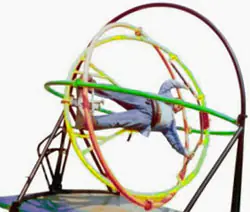Our vestibular apparatus is an inherently unique organ located in the inner ear, responsible for the sense of balance and includes only two components, each of which performs a specific function: the first controls the angular movements of the head, and the second controls the vertical and horizontal positions of the body. They talk a lot about how to train the vestibular apparatus, often forgetting the main thing: this organ is quite closely interconnected with the brain and spinal cord. Almost all sense organs, which are directly dependent on the influence of external factors, take part in its work. At its core, the vestibular apparatus turns into a kind of biocompass. A person with a developed internal compass will not just fall and will have excellent orientation in space, and a sense of balance will serve him well.
We can talk endlessly about the importance of the internal compass, but all the recommendations and reviews will come down to one thing: it needs to be trained, getting used to harsh conditions for the body. But how to train him? - you ask... Well, this is what will be discussed further in this article... At the same time, we will deliberately not tell you the methods of training astronauts or paratroopers - this is aerobatics, and a separate topic for conversation. We will tell you how to use the simplest exercises to improve your tolerance to land, sea or air transport, if you get motion sickness there, how to endure vestibular loads more painlessly and always feel like a “cucumber”... So, buckle up, we are about to take off...
During targeted training of our biocompass, as a rule, a person loads himself to the point of dizziness and nausea, because it is in such conditions that the brain begins to adapt and get used to the new reality.
- Jump! Jumping is one of the exercises used to test pilots and astronauts. It is most effective to jump 180 degrees (with a reverse head turn). Most people experience a release of endolymph during exercise, which causes slight dizziness.
- Rock monotonously. It is most convenient to swing in a hammock, on a swing or on a rope. In this case, it is very important that the movements are without any sudden movements. You should stop only after the onset of dizziness.
- Spin. Remember your childhood, when for the first time you got very excited and felt dizzy... The more you immerse yourself in this state, the more your body develops adaptation and habituation, and this is exactly what we need to train our compass...
- Increase blood flow to the cerebral cortex. To do this, lie on a bench with your head slightly lower than your torso and your legs higher. If in this position you shake your head to the sides, you will independently feel the flow of blood to the cerebral cortex. People suffering from pressure surges should approach this method with caution.
- Don't ignore physical therapy and yoga. Most of the physical exercises known to everyone, one way or another, train the vestibular apparatus. Apart from walking backwards, running, somersaults and playing badminton, yogic asanas can help you. They perfectly develop balance and teach you to control your breathing.



